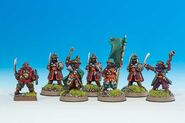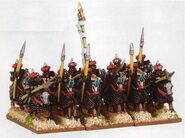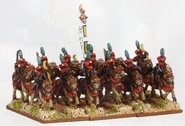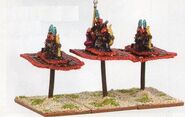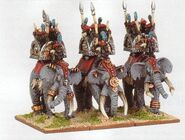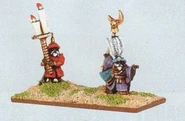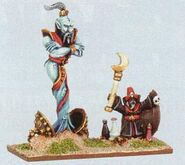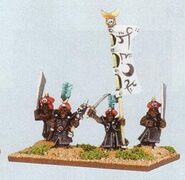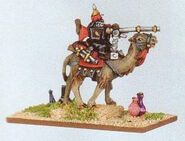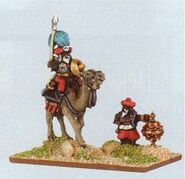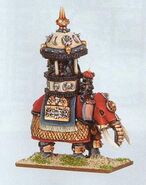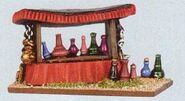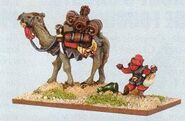Araby is an ancient realm of Men that lies far to the south of the nations of the Old World, home to magnificent cities and savage tribes of desert nomads alike. It is a strange and exotic country, ruled by powerful sultans and desert sheikhs.[21a] Araby is located south of the Old World, west of the Land of the Dead and northwest of the Southlands' rainforests.[4c][11a] It rises across vast expanses of desert, its peoples' cities located on the Coast of Araby, to the west, and on the northern borders of the Southlands.[75]
Little is known about Araby compared to the Old World. Its merchants travel and trade extensively throughout the world, establishing trade networks that span every sea and nation.[11a] Their society is notoriously focused on commerce, piracy, and conquest, [29a] carried out on a global scale, bring them fabulous wealth: their sultans and caliphs are said to be richer than the Dwarfs. This trade is carried beyond the sea thanks to its dhows, fast ships with triangular sails.[11a]
In the past, on many occasions, the Arabyans have tried to establish themselves outside their homes, occupying territories such as Sartosa[3b], and even in the Empire.[7b] But such daring expedition are now rescaled and directed mainly on the Border Princes.[27] Such would be the case of Luyt'ama Rah'slyn,[85a] Fatandira,[86a] or Abdul Al'Shar.[79a] In addition, Arabyans made their own districts in some distant cities, such as Marienburg, where an Arabyan community, known as Arabierstad, has formed. No alcohol is allowed there but it is renowned for its fine private tutors.[12b]
History[]
The Arabians are skilled sailors who, for many centuries, have fished the adjoining seas and engaged in trade—sailing south along the coast, northwards to the Old World, and westwards as far as Ulthuan. However, the High Elves do not permit Arabian vessels to travel further west than Ulthuan itself. Nevertheless, their high-prowed dhows are a common sight in the outer harbours of Lothern.[11a]
On their part, the High Elves have maintained a mercantile presence in Copher and Lashiek for ages. The Elves and men of Araby have had dealings even during the long centuries when the Elves abandoned the Old World.[11a]
But at some point an event would have changed Arabyans' relations with the Asur, the wizard, Mullah Aklan'd, managed to expel the Elves from their colonies in Araby. For this, he's still a revered figure among his people, particularly on his birthplace, the island of Fyrus.[71b]
Within his lifetime the Mullah had reduced the Elven nations to a few pockets of isolated resistance, and taken control of all of their old trade routes. It was at this time that the Sea Elves undertook many of their great journeys across the western seas.[71b]
Not only are Arabians capable seamen, but they are also bold and adventurous. They often transition from fishing and trading to piracy, especially in Lashiek, which has consequently earned the title 'City of Corsairs'."[11a]
War of Death[]
When Nagash was defeated by the last surviving Priest King Alcadizaar just hours after casting the great spell, Arkhan the Black gathered a vast Undead army from those creatures that had been awakened by Nagash's spell. Determined to wreak revenge on all living creatures for the destruction of his lord and master. Arkhan turned south towards the nearest living opponents he could find. For generations Arkhan and the Undead host under his command battered the kingdoms of Araby, in what the Arabian chroniclers came to call the Wars of Death.[50a]
The war started in In -1149 IC when Arkhan's army sacked the city of Bel-Aliad[16b] For the next 1.000 years Arkhan raids the lands of Araby from the desert wilderness that surrounds them. The once mighty civilisation that ruled these lands was reduced to a few weakened city-states and a handful of desert tribes.[50b] Legends say that all the way from Nagashizzar, Nagash turned his gaze upon the defense of Lahmia and used his vast magical powers to aid those whose cult idolized him. The Khemrians and their allies brought forth machineries of war and, though battered by rocks, burned by alchemical fire, and showered with arrows and bolts, Lahmia stood defiant. The many priests of Nehekhara that were arrayed against Lahmia invoked their gods, and the magicians of Araby released the fury of bound djinn to curse the defenders of Lahmia, yet still the vampires fought on, though their mortal servants were slain in their thousands.[24a]
For a full week, Abhorash and Vashanesh led their army against the bronze-clad armies of their enemies, but for all their immense ferocity and skill, and despite the deaths of thousands of their foes, they were unable to stop Alcadizaar from sacking their city. The army of Lahmia was vanquished, and the few mortal survivors of the city turned against their overlords in the last days of the battle. Within the city's walls, desperate mobs had begun to smash the palaces and monuments of Lahmia. The great temple was put to the torch, and those petty and decadent vampires who had chosen to hide within it rather than fight were reduced to ash by the raging flames and then scattered on the warm breeze across the desert, never to be revived again. Many of the vampiric princes and princesses of Lahmia met their end in this way. Many more who managed to flee were hunted down and killed by the vengeful Nehekharans and their priests. Only the very strongest vampires escaped, amongst them the trueborn of their kind: Neferata, Vashanesh, Abhorash, Ushoran, W'soran, Harakhte, and Maatmeses. Perhaps drawn to the Lord of Undeath by some instinct, these seven great masters of all vampires fled northward and one by one arrived in Nagashizzar.[24a]
Neferata's Intrigue (-1152 to -1147 IC)[]
After the fall of Lahmia to the combined forces of Nehekhara, Neferata retreated to Araby. In -1152 IC Neferata led her warriors with a relentless fury towards the Arabyan city of Bel-Aliad, determined to claim the city as her own in the absence of her beloved Lahmia. Draped in black robes and leather armor, she rode her savage desert stallion over the barricades, her sword striking like a scorpion's sting, severing spears and hands with deadly precision.[80c]
As her handmaidens joined the fray, the defenders faltered, overwhelmed by the ferocity of Neferata's assault. She howled commands, rallying her forces with bitter determination. Bel Aliad was but a shadow of the glorious Nehekhara tomb-cities, yet she intended to make it hers, a defiant resurgence despite the looming threats of Alcadizzar and Nagash.[80c]
Amid the melee, Neferata was grimly aware of Nagash's sinister hand orchestrating the downfall of Nehekhara. The Great Plague was spreading, sowing death and despair across the land. Neferata harbored a mix of satisfaction and pragmatism; while part of her relished the decline of her homeland, she recognized Nagash's insatiable ambition for total dominion.[80c]
With time running short, Neferata saw a glimmer of hope in seizing Bel Aliad and unifying the caliphates against Nagash. She contemplated confronting the Great Necromancer head-on, knowing there was no escape from his relentless pursuit.[80c]
Engaged in combat with a formidable warrior named Khaled al Muntasir, Neferata faced a chilling revelation about the sword he wielded—an ancient, fell weapon with inscrutable sigils, possibly of daemon origin. She intended to study it after wresting it from Khaled's grasp.[80c]
Despite her persuasive efforts, Khaled resisted her mental influence, and the confrontation escalated. Neferata's battle prowess was tested when Khaled's sword seemed to throb with unnatural energy, threatening her very existence. As night descended and chaos reigned, Neferata found herself cornered by the armored Kontoi warriors of Bel Aliad. In the skirmish that followed, she recognized the danger posed by Khaled's weapon and sought to disarm him. However, a sudden shout diverted her attention.[80c]
Before she could react, a lance struck Neferata, impaling her against a wall. Her agonized screams echoed through the night as she struggled in vain, blood and foam staining her front. Despite Khaled's attempt to free her, Neferata faced a grim fate as the sword pierced her heart, darkness encroaching. In her final moments, she glimpsed the wielder of the lance—the legendary vampire Abhorash, bearing a disapproving gaze. As darkness claimed her, Neferata carried her defiance into the abyss, her legacy entwined with the looming specter of Nagash's relentless pursuit of dominion.[80c]
Khaled then kept the paralysed body of the vampire queen in a ornate sarcophagus as a prize.[80d] A temporary cage that could not hold the vampire for long.[80e]
Just five years later -1147 IC, Neferata was already active like her schemes and was navigating the bustling streets of Lashiek the Corsair City with a purpose, her handmaidens trailing behind her in similar veiled attire. The once-vibrant Araby had succumbed to ruin, thanks to Arkhan's relentless assault, forcing Neferata to abandon her intricate schemes for more direct pursuits. As she paused to observe passing soldiers, memories of Bel Aliad's destruction weighed heavily on Khaled, who had lost both ambition and vigor amid the chaos.[80e]
Spotting a flash of red, Naaima directed Neferata's attention towards a nearby shisha house, where Anmar awaited them in a crimson robe. Anmar's presence exuded determination, a stark contrast to Khaled's despondency, representing both sibling's divergent responses to Bel Aliad's fall.[80e]
Inside a shisha house, Anmar bin Muntasir, anothe ally of Neferata, introduced Ilsa, a trembling slave gifted by the Dowager Concubine, the defacto ruler of the city Lashiek to Neferata. Neferata's smile beneath her veil revealed her satisfaction with the arrangement. Despite leaving Araby behind, her influence and connections endured through alliances like the one with the Dowager Concubine. With Ilsa's linguistic abilities, Neferata envisioned leveraging her presence in the republic of Sartosa to further her ambitions.[80e]
Neferata's mesmerizing gaze fell upon the terrified Ilsa, soothing her fears with calculated charm. In this tumultuous transition, Neferata's intentions remained clear—to cultivate new power bases and extend her influence beyond the fallen sands of Araby. With Ilsa's role secured, the journey to Sartosa signaled a new chapter in Neferata's unfolding legacy, one where she would adapt her cunning to the treacherous seas beyond.[80e]
Ibn Jellaba's Journey (ca. 1150 IC)[]
The Corsairs of Araby have attempted to search for reaches in the Soutlands for many centuries.[15a]
Ibn Jellaba was a trader of Araby intent on opening up a trade route into the interior of the Southlands to procure spices and gold. He trekked over the desert with a camel caravan until he reached the jungles of the Southlands. Here he encountered the Lizardmen city of Zlatlan which had remained hidden for millennia. This Lizardmen realm far to the south of the great desert was known to the Arabyans only by rumour and legend, and the uncertain reports of chance encounters between desert nomads and the dreaded Al Saurim.[14a][15b][18a]
After the encounter Ibn reached Ka-Sabar and reported that there was no practical overland route to the southern seas. He also told the Sultan about the powerful armies of the lost realm of the Al Saurim who controlled the hinterland and that they had no interest in opening up trade links with anyone. Although the Sultan was disappointed with this news, he was delighted with the vast treasure brought back by lbn's caravan. Not only were lbn and all his men rewarded, but there was enough wealth left over to equip a new fleet of war dhows to challenge the High Elves and Cathayans for the southern spice trade routes.[14a][15b][18a]
Conquest of Sartosa (1240 IC)[]
An invasion fleet attacked the island of Sartosa in the year 1240 IC, overpowering the descendants of the Norse who had inhabited Sartosa since 1017 IC. For the next 250 years, the Arabyan corsairs ruled the island, threatened Tilea's shipping, and fought several sea battles with the galleys from Luccini, Remas, and Tobaro. The island would remain in Araby's control until 1501 IC when the island was reclaimed by the Prince of Luccini, Luciano Catena.[3c]
The Crusades (1448-1475 IC)[]
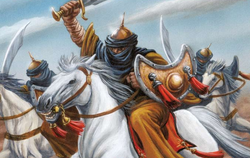
Arabyans sacking the lands of Estalia.
In the imperial year 1448, Sultan Jaffar, the despotic ruler of Araby, invaded Estalia with a vast horde of warriors from the desert tribes. Despite the determined resistance of the Estalians, the great city of Magritta soon fell to the invaders. These events spread alarm throughout the Old World. Bretonnia's king, Louis the Righteous, raised a powerful army of Knights to liberate Estalia and punish Jaffar. The host marched towards Estalia, reinforcements from distant lands following in their wake. The king of Bretonnia allied with the knights of the Empire and Tilea to cross his true gateway to Estalia.[1a]
Only the Tilean city-state of Tobaro managed to resist the invading force. During the Conquests of Estalia, Tobaro proved invaluable as a safe haven from which the crusading forces could be based during the defense and re-conquest. Over the course of the Conquests, the city was besieged from both land and sea on five separate occasions but did not fall.[78a]
These forces joined the Estalians who still resisted and gathered into a huge army with many contingents. After many hard fights. Sultan Jaffar's armies began to retreat. Magritta was recaptured, but the sultan and most of his army fled to Araby.[1a]
Estalia, and the city of Magritta in particular, had endured the ravages of Jaffar and his army. This had given all those who had fought to save Estalia the desire for revenge. They decided to pursue Jaffar back to Araby.[1a]
When the Crusaders landed in Araby they were unprepared for the desert heat and lack of water. Progress was slow and Jaffar's forces, being adequately equipped and highly mobile, managed to avoid being surprised in a pitched battle, simply deserted and disappeared into the vast desert awaiting the outcome.[1a]
The Sultan's best general Mehmed-bey, won a major victory against the crusaders at the Battle of the Nine Jackals. The Crusaders had been tasked with taking an oasis, which the general allowed only after the magic of his Fakirs had changed the water into wine. Despairing of thirst, the knights had been forced to fend off the assaults of Mehmed's Akincis, fast nomad lancers and horse-archers. Wearing down their resolve, the Arabyans forced the crusaders to drink the magic wine - a liquor of such potency that neither man nor horse could withstand its properties. With the crusaders now helpless, Mehmed-bey attacked the oasis one last time, employing his armoured Sipahis to massacre the defenceless Bretonnians. The Arabyan knights took the oasis without a casualty. Those crusaders he captured alive Mehmed ordered hung by their feet from the palm trees, their mouths filled with salt and their lips sewn tight with twine. One man alone did the brutal general spare, allowing him to ride away and bear the tale to his countrymen, and this messenger Mehmed ensured would never bear arms against the Sultan again by chopping off his hands before setting him on his horse.[25a]
The sultan’s army was finally brought to bay at the Battle of El Haikk. Mehmed Bay raised a vast army and rode to the cornered sultan's aid. Despite outnumbering the crusaders greatly, the Arabyans were smashed by the knights. Medmed Bay was personally killed by the Duke of Aquitaine. This defeat sealed the fate of Jaffar’s empire. Araby, however. proved too vast and hostile to be properly conquered and held. Instead, the crusading knights demolished fortifications, burned evil books, flung down the idols, and carried off as much treasure and exotic luxuries as they could find. As they sailed for home, they burned Jaffar’s fleet of warships for good measure. No sooner had they left than nomad tribes swept in from the desert to divide Jaffar’s realm among themselves.[1a][25a]
Arabyan Counterattacks (1500 to 1600 IC)[]
Arabyan generals soon decided to lead counter raids of their own against the northern kingdoms of men. However, all of these would see limited success and were soon offset by even more losses. Abdul Al'Shar planned to attack the Empire in revenge for the Crusades in 1500 IC. For this he invaded the Border Princes and attacked the belligerent Greenskins and warlords there, until he formed a stable kingdom and began to gather strength. He created a small kingdom near Masserschloss in which he hoped to augment his forces with mercenaries and plant enough crops to feed his army. What he found was a Greenskin-infested land, so the Prince led his army north, but watched with horror as each new confrontation with the Orcs reduced his numbers, undid his plans, and destroyed his dreams of conquest. Faced with annihilation, he settled on a piece of land and ruled over scattered hamlets and distressed villages. He invested more resources when his scouts discovered an area rich in iron. Months passed, and it seemed less and less likely that Abdul would recover from the initial invasion, and a year later, one of his lackeys assassinated him while he was sitting on his chamber pot. For the next 200 years, Abdul's principalities were ruled by a series of lesser men until their little law crumbled under the weight of their own corruption. The iron mines dried up, the land was fragmented and entire region simply fell to the Greenskins, to later be occupied by other ambitious Humans.[79a]
Also in 1500 IC, Sultan Daryus-e Qabir launched a series of religious wars against the Old World in the lands of Tilea and Estalia, without any lasting success. Legends dating from this time have coloured Old World attitudes to inhabitants of Araby. This failure would also result in Tilean offensives towards the island stronghold of Sartosa.[4c]
In 1501 IC, the island of Sartosa was conquered by the Tilea city of Luccini under Luciano Catena. The last emir, Abd al Wazaq, fought a long a bloody siege against the Tileans until he was forced to surrender. Such was the Emir's desperation, that he converted his harem into an all female bodyguard unit. Upon capturing the city, the bodyguards were hired as mercenaries, marking the first time Arabyans served as mercenaries for the Tileans. The Emire was allowed to return to Araby in shame, leaving behind enormous treasure for Luccini. Sartosa would become a naval base for Luccini's mercenaries for several generations after this.[3b]
The Crimson River (2103 IC)[]
In late 2103 IC, the Bloodhunt Tribe resolved to offer skulls from far-off lands to the Blood God, and took to the seas in their longships. Heading south, they eventually came across the desert realm of Araby, though the Northmen numbered less than a hundred and the armies of Araby were many thousands strong, the warriors of chaos carved a path of conquest across the land. The emirs of those far-off kingdoms sent sentient winds and fiery spirits, but to their despair, the followers of Khorne grew more determined with every battle.[42a]
The trail that the invaders hacked through the armies sent to oppose them was marked with spatters and pools of blood that, as the days of battle grew long, ran together between the dunes as rivulets of crimson. The emirs sent their elite bodyguards and cavalry regiments against the indomitable chaos warrior footsoldiers, but to no avail. The warriors of chaos fought with a berserk fury, and soon the rivulets became a stream.[42a]
In desperation, the emirs sent gigantic beasts of war and armies that hid the dunes with their number. It was not long before the stream had become a river though every Northman was eventually killed, their master Khorne was truly pleased, and the Crimson River flows through Araby to this day in testament to their sacrifice.[42a]
The Eye of Osiris[]
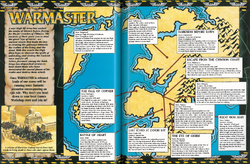
A map of the numerous battles fought by the High Elves of Ulthuan in their quest to steal all the pieces of the Eye of Osiris.[67a]
During the quest for the Eye of Osiris, a vast High Elf army has sacked the tombs of Khemri before fleeing to the far reaches of Ulthuan. The purpose of their quest was to steal the great "Eye of Osiris," an ancient oracle that holds the key to crossing the gateways between the realms of the living and the dead. With this oracle, the High Elves hope to discover the spells of unbinding and destroy the Undead once and for all. Settra, foremost among the Tomb Kings, has dispatched armies to hunt down those who have desecrated the sacred places of his realm and destroy them utterly.[67a]
Geography[]
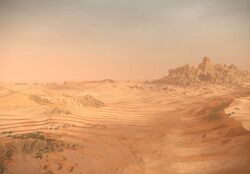
Dunes of the Arabyan desert
The land of Araby lies along the north west coast of the Southlands between the Atalan Mountains and the Great Ocean. To the east is the Great Desert of Araby that separates Araby from the Lands of the Dead.[11a] Araby is a hot, dry place, where water is scarce and few areas are really fertile. Much of the land is desert or shrub land, requiring careful irrigation to produce crops.[4b] Although the climate is dry and hot the western winds carry moisture laden clouds that give up their water as they are suddenly forced upwards by tall Atalan peaks. The resultant rain falls upon the mountains and gives rise to numerous seasonal streams that, in winter at least, form substantial westward flowing rivers. Although much of the land is dry the rivers bring the water needed by cities, towns and villages, there are also numerous oasis even in the arid regions to the south.[11a]
Geographically, Araby is divided between the territories of the Coast of Araby, northwest of the Atalan Mountains, and the Great Desert of Araby, known to the Arabyans as the Sahra Desert, where some important cities still lie. The domains of the Great Sultan extend to the border of the Southlands, where Ka-Sabar stands as the last Arabyan stronghold on the way south. Vast expanses of desert, dotted with small oases, are the norm in this region of the world, where heat and aridity are untouched.[11a][75] Anyone who travels through the desert should know the Harmattan, a dangerous wind that attracts sand storms, being able to hide the sun for days, as well as bury the unwary under the dunes.[41a]
To the south, a natural enclave vital to the economy is the Gulf of Medes, where El-Kalabad rises. It receives a good part of the commerce coming from the east, being therefore a place of constant commercial traffic. To the north of Araby is the Old World, and to the northwest Ulthuan, and that is why Araby maintains control over the trade routes of the far east. Ships from Cathay and Ind flock to their ports after a long voyage around the Southlands. Its strategic location helps them maintain hegemony over commerce, monopolizing entire routes.[11a][14a]
Like the Old World there are a number of remnants of other, declining races, who still survive in remote areas. As much of Araby is desert, remote areas are fairly common. The Worlds Edge Mountains are there, as everywhere, full of Goblin strongholds and underground dwellings.[17a]
Maritime Locations[]
- Bay of Corsairs - During the centuries many infamous barbarians have plagued this region. Erik Redaxe,[83a] and Rakarth the Beastlord had laid waste to towns and ports wet by the Bay of Corsairs.[82][75]
- Great Ocean - The Great Ocean links Araby to the New World in the west.[11a]
- Gulf of Medes - The Gulf of Medes is were the colony of Sudenburg was erected by the Old Worlders.[11a]
- Horn of Araby - Anyone wanting to move goods from The Horn of Araby to anywhere past the Estalian coast — Bretonnia, Marienburg, Erengrad, anywhere — has to pass through here. The Magrittan fleet has recently been maneuvering around the southern tip of Estalia to intercept foreign vessels. Nothing gets through without paying taxes to the crown of Magritta.[54] Traversing around the Horn is an eventful journey; few sailors can claim to have managed it. One of these is the Sartosan pirate Jeremiah Tusk, though the dangers he and his crew witnessed remain forever shrouded in mystery, rich material for stories told by other buccaneers of the sea.[45a]
- Sorcers' Islands - The Sorcers' Islands are located in the west coast of Araby.[75]
- Southern Sea - Sea between Estalia and the north-west coast of Araby.[75]
Mountains and Plains[]
- Atalan Mountains - East of the Atalan mountains the great desert stretches for hundreds of miles towards the Land of the Dead. The eastern mountain valleys support the odd sheltered oasis and help to provide enough water for nomad tribes who live in the shadows of the mountains and make a living by escorting convoys through the treacherous passes.[11a][61a]
- Eye of the Panther - A mountain in the northeast of the Atalan Mountains.[75] It is reach of gemstones.[61a]
- Eunuch Mountain - The Eunuch Mountain is a mountain west of the Atalans.[75]
- Great Erg - The Great Erg is a blistering, white sand plain visible to the south through the mouth of the valley near the city of Zarekten - and the rich trade routes running through it. It represented the last frontier between the principalities and city-states of the prosperous north, and the nomadic tribes who inhabit the deserts to the south.[87]
- Vulture Mountain - The Vulture Mountain is a mountain east of the Atalans.[75]
Rivers[]
- Crimson River - A river generated by the blood that flowed in 2103 IC during a raid made by the followers of Khorne of the Gorehunt Tribe.[42a]
- River of Serpents - The river that splits the drier lands of Araby to its south, from the more populated northern regions.[11a] The only river that corresponds to such a description lies near the city of Lashiek.[75]
Deserts and Oasis[]
- Land of Dervishes - A desertic area inhabitated by the Dervishes tribe.[75]
- Oasis of a Thousand and One Camels.[75]
- Sahra Desert - Also known as the Great Desert of Araby,[11a], or Malaluk Desert,[24b] this arid region separates Araby from the Lands of the Dead.[75]
- Shifting Sands - A desertic area near the border with the Land of the Dead.[75]
Settlements[]
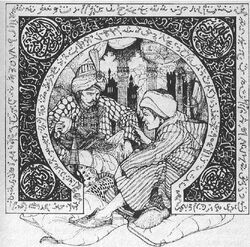
Orfeo the Minstrel and Alkadi Nasreen talk in Arjijil
Most of the Arabyan city-states sit on the western coast of the continent, as the center is dominated by the Great Desert of Araby, which itself is populated with nomads.[11a] Beyond the Great Desert lies the city of Bel-Aliad, the closest human settlement to the Land of the Dead, now ravaged. There is no notable settlements in Araby beyond the Atalan Mountains.[17b]
From the ports of Araby exotic animals from these territories are sold on the markets, beasts sometimes hard to tame just as reptiles that breathed fire, or other monstrosities are a nightmare to maintain for their captors.[81a]
Arabyan cities are exotic and extravagant, where massive vaulted palaces, filled with wealth beyond any imagination, loom over adobe and stucco houses in winding streets.[28]
Edit's Bookmark: Federico da Remas[]
-- Feel free to help but check the sources in first person, all the info under the alert template is compromised by non-canon info. To-do list: Better merging between arguments. -- Add all location in [20c] --
- Aiir - Aiir is an Arabyan city with several minor vassal settlements under the same ruler. Their current sultan is Hamqa the Divine, a wealthy merchant.[54]Template:OK
- Al-Haikk - Known also as Alhaka, Al-Haikk means the "City of Thieves" in Arabyan,[11a] it is one of the largest commercial port in Araby. Home of the Great Sultan, it is a hub of commerce and serves as capital of all Araby.[89a]Template:OK
- Amhabal - A city renown for its rugs of great beauty since at least 2010 IC.[55a]Template:OK
- Arjijil - Considered by the Old Worlders an infamous nest of pirates. Its citadel is said to be impregnable, and it houses the servants of one who styles himself Caliph of Mahabbah and Lord of the Twin Seas, Alkadi Nasreen.[43a]Template:OK
- Bur-Shitrak - Bur-Shitrak is an Arabyan settlement, some Sea Elves trade in Bur-Shitrak to collect exotic animals such as the desert-hound called Mukkavi to sell them in markets of the Old World such as Marienburg.[12c]Template:OK
- Djambiya - Is a port city located not far from the borders of the Land of the Death. Its people are tremendously superstitious, and fear to enter the desert and the ruin of the Land of the Dead.[31b]Template:OK
- El-Kalabad - El-Kalabad is an Arabyan trading port located on the Gulf of Medes, in the south of Araby.[20c]Template:OK
- El-Khabbath - Located to the west of Zandri,[48a] El-Khabbath is a destination for those students of the arcane who want to delve into branches of magic little known in the Empire, such as the control of the light-djinn, Jovi Sunscryer of the Light Order, was tutored in the city by the Golden Magus in the arts of the summoning of these elementals.[33a]Template:OK
- Fyrus - Is an island near the coast of Al-Haikk, whose city was occupied during the crusades by the Knights of Origo, to be later recovered by the throne of Araby. It is a highly revered place, as Mullah Aklan'd, the first Great Sultan of Araby, was born there.[56a]
- Gobi-Alain - Upon driving the Sultan Jaffar's forces from Estalia, the armies of the Old World had followed them over the sea and into their own land. Prince Friedrich Weiss, commander of the first grand crusade from Wissenburg desired to build a reputation on the field of battle in Araby. Prince Friedrich's crusade had burnt and slaughtered its way into Araby for many miles inland. It had breached the walls of Gobi-Alain on the coast and defeated every hastily mustered army that marched to meet it.[19a][87]Template:OK
- Jabal Sin jar - Jabal Sin jar is a fabled city across the desert, if legends are true it is full of riches which have planted a kernel of greed in many men even from beyond the sea.[87]Template:OK
- Kadira - A port on the Gulf of Araby, it was harassed in the past by the Orc pirate, Uragh Goldtusk.[43a]
- Kamt - Situated on the eastern limits of Araby, this city is famous for its rulers' interest in the arts. Its courts are full of skilled musicians, sculptors, poets, and actors. It is a center of culture, attracting many artists from the Old World to perform.[43a]
- Ka-Sabar - It is the southernmost city in Araby, located on the edge of the jungles of the Southlands. It is an ancient city of Nehekhara but was destroyed by Nagash' forces. It was later inhabited and rebuilt by the Arabyans to become one of the richest cities in all the land. It is home to the Ka-Sabar Academy
- Kust - Located in the southwest of Araby, it is a vassal of the city of Aiir. Its ruler is Hamqa the Divine, Regal of Kust.[54]Template:OK
- Lashiek - Known as the City of Corsairs, the mighty Arabyan fleet is located there. It is also feared as the world center of the slave trade which is guarded by its Harem Guard.
- Mahabbah - A caliphate, Alkadi Nasreen, self-styled himself Caliph of Mahabbah.[43]
- Martek - A city of unimaginable luxury it once served as false Sultan Jaffar's supply of wealth due to the vast mining insitutions stationed there.[18a]
- Meknes - A port ruled by Hamqa the Divine, which hosts his fleet.[54]Template:OK
- Palace of the Wizard Caliph - This palace is located in the southern tip of the Atalan Mountains.[75] It is spoken throughout Araby that there is little about the art of sorcery that the Wizard Caliph does not know, and he specialises in the lifting and laying of curses. Of course for any service the Caliph is sure to ask a favour in return.[21a]Template:OK
- Ras Karim - City located between Al-Haikk and Copher, famous for its large docks and its commercial influx. It is currently ruled by Princess Yuleh it Toorissi, after the tyrannical and cruel government of her cousin was overthrown.[28]
- Sadiz - Vassa settlement of Aiir. Its leader receives the title of Suzerain despite being Aiir's vassal. It has been a custom amongst the male line of the suzerains of Sadiz that the woman from their harem who last had sexual congress with the husband wears an item of the husband's clothing to show her status as favourite.[54]Template:OK
- Sanaá - Arabyan city in which the sorcerer Abdul Alhazred was born.[58a]
- Songhai - Situated in southern Araby, this city is ruled by an influential king, with power that rivals the sultans. It is thanks to the Sultan's harsh control of the southern trade routes that the Songhai throne has managed to rise to such a position.[43a]
- Sud - City located in western Araby, south of Lashiek and the Palace of the Wizard Caliph. It is one of the cities with the greatest presence of people from the north, and its merchants come to venture to distant lands, such as Albion, in search of strange products.[43a]
- Sudrat - A city renown for its rugs of great beauty since at least 2010 IC.[55a]Template:OK
- Teshert - Fortified city, located beyond Araby, at the southern tip of the Badlands. The powerful host that garrisons Teshert secures the only route linking Araby with Barak Varr and the Border Princes, being a safe passage for the caravans. The city's emir rules over the adjoining desert, called Marg Beh-Mard, plagued with monsters and dangers.[43a]
- Zarekten - Zarekten was one of the cities besieged during the first grand crusade. Its strategic position allowed it to dominate the valley.[87]
Foreign Colonies in Araby[]
- Antoch - Formerly known as the "Crusader City," it was founded by Bretonnian knights after the Crusades against Araby on the northern coast of the Gulf of Medes. It was destroyed in ca. 2500 IC by the Lizardmen, who sought to recover an artefact stolen some 700 years before by Pierre d'Antoch.[22a]
- Elven Ruins of Araby - The remains of a coastal city are found on the southern tip of Araby, testifying that probably the coast of Araby was once a colony of the High Elves.[75]
Uninhabited[]
- Bel-Aliad - An ancient Nehekharan city later settled by Arabyans. It is currently in ruins and engulfed by the desert sand. It was once the capital of Araby, when it was a proud and united civilization, until it was destroyed by the Undead raised by Arkhan the Black in -1149 IC. Precious treasures are said to be hidden in these ruins, but few adventurers return to confirm the stories.[60a]
- Dakisir - Ancient Arabyan city, now reduced to a handful of ruins engulfed by sand. It was famous for its forges, where magical weapons of legendary quality were made. It was destroyed by the Undead of Arkhan the Black during the War of Death.[3a]
Flora and Fauna[]
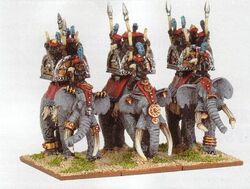
In Araby we can find an exotic and varied fauna, lost in the immensity of the dunes. Lions, Giant Wolves and panthers are common creatures in the Southlands, as well as in many regions of Araby.[51a][52a] Camels are essential for life in the desert, being used by both merchants and warriors.[11a] Jackals roam the deserts, being frequent in mountainous areas. They are a very common pet in Araby, also used for dog racing.[12c][31a] We know of the existence of the Radiant Pegasus, inhabitants of the sunny plateaus of Araby. They are dangerous creatures, with the power to burn their enemy with a powerful blaze.[34b] Creatures from the southern jungles roam the dunes, such as elephants or great apes. Immense Giant Serpent also inhabit these territories, and many of these beings end up in the private zoos of the sultans, who love to collect strange creatures.[28] Giant Vultures also live in the mountains of Araby, large enough to carry a horse between their claws, which the Arabyans are capable of using for war.[1a]
The Arabyan seas are extremely rich in fauna, which is why fishing is an essential food source for the Arabyans.[11a] Although we not only found small schools of fish. The dolphins hover between the boats, jumping around the bow. Along with them, dangerous sharks are waiting on the prowl, ready to pounce on the most unwary sailor. Their number is such that they give their name to the strait that separates the Land of the Assassins from the Sorcerers Islands, known as the Strait of Sharks.[53][75] Although in the Arabyan seas, the most dangerous being are the leviathans of the deep, whose jaws can devour the strongest ship with little effort.[53]
The Arabyans are in the habit of using poisons in their weapons, extracted from creatures of the desert.[41a] They would highlight, for example, the Green Scorpion Venom, or the Viper's Kiss, which is obtained from the deadly black speckled vipers.[30g] Another animal from which poison is extracted is the Tomb Scarab. With a drop of his poison, spilled on an Undead bone placed on a rope, he will form a pendulum. This pendulum will swing in the direction of the nearest vampire, being used by the warriors of Araby to locate vampires in their lands. Although those who use the pendulum must be careful, because the poison of the Tomb Scarab never loses its effectiveness, and can be a deadly weapon.[36b] Another famous poison is the one that is extracted from the Black Lotus, which grows in a plains in southern Araby known as the Black Plains.[12d]
Other great creatures roam the lands of Araby. The dune dragons are maybe the most dangerous predators, but their blood is told to have magical proprerties without price.[84a]
Government[]
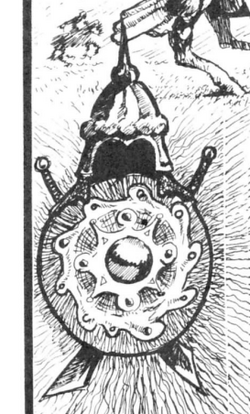
An Arabyan symbol[29a]
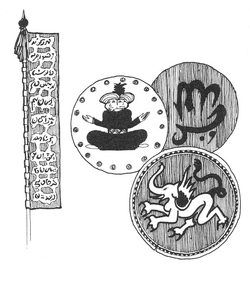
A collection of Arabyan symbols
The Sultan of All Araby claims to rule the whole peninsula, but has little real power over the independent coastal city-states or over the fierce nomad tribes who wander the Great Desert of Araby. The power wielded by the Great Sultan from Al-Haikk, the capital of all Araby, is supported by the fickle loyalty of the nobles. The Arabyans Princes and Emirs, the noble class among the Arabyans, tend to be very independent, as well as the rest of the Sultans, ruling their cities with impunity.[11a] [18a] Even the Sheiks and Emirs of the land are constantly warring with each other.[23a] The fierce Sheikhs of the desert are local leaders, being renowned warriors and military men. In most cases they are the Viziers, personal advisers of the Sultans, those in charge of commanding the armies on the battlefield, with the notable exception of the Great Sultan. This is so because the Sultans of Copher, Lashiek, Martek, Ka-Sabar, Aiir, and El-Kalabad live in unimaginable luxury. They are served by hundreds of slaves who will fulfill all their whims, their harems are full of voluptuous beauties from all over the world and their treasure chambers with all the splendor and wealth of this distant land. That is why they are reluctant to step on the battlefield, preferring to delegate their viziers to command their armies.[11a] [18a] Arabyans women have the same inheritance rights as men, and can rule cities as princess, or even become Sultans.[28] Among nomadic tribes there is also this norm, since they have no major problem being led by a woman, both in government and on the battlefield.[27]
Citizens[]
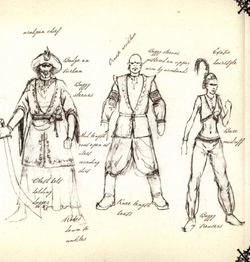
Arabyan chiefs[19a]
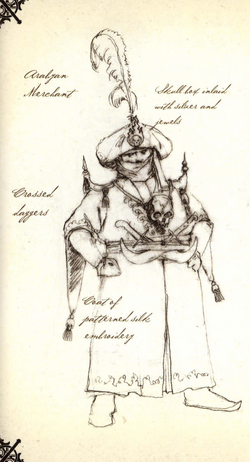
An Arabyan merchant[19a]
Arabyans, also known as Easterners, are a colourful people, sometimes cruel, but always involved in some exotic adventure.[29a]
The toughest warriors come from the nomadic desert tribes, who are highly feared by the more civilized merchants who roam the caravan routes through the vast deserts.[11a][29a] The most notable warriors of Araby are the Dervishes, warriors and religious fanatics all too willing to die for their faith. Other very famous are the Eunuch Warriors, individuals trained from birth to serve as soldiers or guards.[17b]
In the bazaars and markets of Araby, crowds often gather around a seated Arabyan mystic playing a flute. Hypnotizing through music, though some say using his rhythmic swaying, a deadly poisonous snake. Snake Charmers generally survive on the money they earn as artists, but often some offer their services, and that of their snakes, as warriors.[31c] Likewise, Southlanders from the jungles come to Araby to serve as warriors and mercenaries, as well as many other races, such as Ogres.[11a]
Nomadic Tribes[]
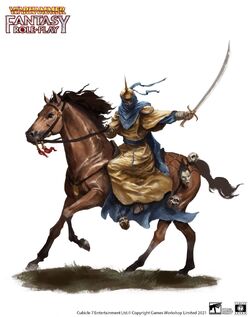
The people of Araby would be divided between those who live in the cities, considered more civilised, and the fierce nomads who roam the dunes, ruled by the Sheikhs of the Desert. The nomadic inhabitants of the desert dwelt in Araby from its foundation, but after the War of the Death, their number skyrocketed.[50a] The destruction of Bel-Aliad, and many other cities of the Great Desert, such as Dakisir[3a], forced its inhabitants to become nomads, roaming the dunes in search of resources. The stories of this time have been kept in the collective memory of the tribes, through stories and songs, recalling the torment that the Undead brought to their land. Some tribes tend to occupy a specific territory, while others travel to distant lands, reaching the Border Princes or the Empire itself.[11a][32c]
Within each tribe the hierarchy is clear. The Sheikh, the undisputed leader of the tribe, is the sovereign. He can be given many names, but this figure always exists as the supreme authority.[32c][49a] The second power is held by the Ani Mukta, the oldest woman in the tribe, who represents wisdom. She has many brave warriors as her personal guard. The ambitious and young warriors hold the next ranks of power, being the ones in charge of keeping the tribe safe. Many tribes consider the horse a sacred animal, and resolve disputes and conflicts with races through the desert.[49a]
In ancient times, there was an Alcazzar, a Sheikh of Sheikhs, who united all the tribes under his banner. The strength of him were fearsome, true legends in the songs of the nomads. The last of them was Shahid the Red Fox, but after perishing fighting Nagash alongside the Seven Kings, no one has managed to claim the title again.[49a]
Some nomadic tribe became part of the Nehekharan army during the reign of Rakaph III, of the second dinasty, before his rule they were employed just as mercenaries. Rakaph granted these tribes the freedom of the desert, the protection of his grand armies, and as much gold as their chieftains could carry, in exchange for an annual tithe of warriors who would swear an oath of unswerving loyalty and obedience to the king. Ever since then, the kings of ancient Nehekhara maintained strong contingents of horse archers among their armies.[20c]
There are hundreds of different tribes of nomads - the Tuareg, the Dervishes, the northern Fuzzywuzzies, the Al'Rahem and the near-legendary Muktarhin to mention but a few. Although they have a very fastidious code of honour between them, which to many Old Worlders would appear almost ritualistic, many bitter rivalries and blood feuds often nare up between tribes over the slightest of things.[32a]
These blood feuds are so brutal they can last for generations and make a Tilean vendetta seem like a child's argument over a broken toy! A strange people by all accounts and with many bizarre customs and superstitions they are difficult people to deal with, especially for Old Worlders whom they view with suspicion and dislike. They are, however, masters of desert survival and any Old Worlder explorer hoping to survive in the unforgiving deserts of their land will need a nomad guide just to stay alive. These hardy people can live in the deep desert for months travelling from oasis to oasis, navigating using the stars and knowing how to avoid the worst dangers of the desert.[32a]
Nomads are also justly feared as raiders and bandits because in their culture stealing is a just and righteous thing to do so long as it is from a rival tribe. Theft within the tribe is most harshly dealt with.[32a]
Some nomadic tribes occasionally wander into the Lands of the Dead but this is rare and mainly because they have become lost in a freak sandstorm. Generally speaking, even Nomads will not travel for long within these dread lands, for theirs is an ancient people whose ancestors once traded with the Nehekarans before the catastrophe. Tales and songs are passed down through generations warning the tribe of the fall of the kingdoms of the west and of the curse of the one they call Nagash the Black. For this reason, they seldom venture too close to the legendary cities of the Tomb Kings. Sometimes though, a young sheikh eager to prove his worth in the tales of his people will seek out knowledge of the Land of the Dead so that he may claim a name for himself and discover untold riches. Needless to say, many of these reckless individuals and their bands of loyal followers are never seen or heard of again.[32a]
Notable Tribes[]
- Al'Rahem - A nomad tribe.[32a]
- Bani-al-Akhtar - The fiercest of the desert clans. Ubaid, Neferata’s chief thrall, and Alcadizzar’s former personal servant, is a nazir, a desert lion, who could trace his lineage back to the great chieftains of this clan.[49a]
- Bedouins - An elusive Arabyan tribe living in retreat in the desert, and trying to avoid all contact.[32c]
- Dervishes - A nomad tribe.[32a]
- Fuzzy-wuzzies- A northern nomad tribe.[32a]
- Muktarhin - Legendary tribe. Some members of this tribe are part of the mercenary company known as the Desert Dogs.[3a][32a]
- Qu'rashi - A tribe that claims that Nagash lived among them and sired a child.[72a]
- Scythans - A tribe of nomads that came to the city of Numas at a certain time, and these, believing that Prince Tutankhanut was an incarnation of their god, worshiped him, occupying and rehabilitating the city. They inhabit in harmony with the dead, recovering the former glory of Numas.[20b]
Culture and Society[]
"The land of Araby it is called. A snow settles on the mountain here, so the sun settles on the great wastes of the Arabyans. Golden temples and ancient cities full of gems and jewels lie in the desert, or so it is said. The Arabyans are a fierce, independent people, with skins of tanned leather, long flowing robes and they ride upon strange horses with great humped backs that can walk for days without water. And as well they should, for the sun drinks all water except for a few pools and trickling rivers. It is death to travel the desert."
- —Tales of the Norsmen about the lands of Araby.[73a]
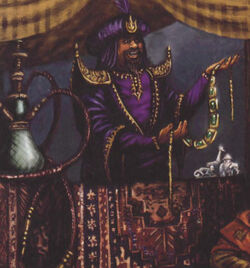
An Arabyan jewelry seller
Most people think that the mysterious land of Araby is a barren land, ruled by savage heathens. And to an extent it is. It is well known that the populous is godless and bereft of faith. Their ways surely differ from the ones in the Old World, but there is much to admire. Arabyans are proud. They speak in loud, quick voices and vibrancy runs hot in their veins, heated by the burning sun. They are energetic people, overflowing with passion and indomitable spirit. Their coastal cities are centres of trade and commerce: long ships from the north pass sleek corsairs in the green deltas, Empire galleys skin the treacherous coastlines and tall Bretonnian sloops bring their wines to trade for silks and spices. No cities excite the imagination like those of Araby. Arabyans are not savages. They possess a proud civilisation, and have made great advances, especially in science, medicine and architecture. They champion the arts, It is only when one enters the southern portion of the land that civilisation ceases. The great sand desert, mountain ranges and valley passes are crawling with warring hill tribes and bandits. It is as if the land is divided in two. But for those who visit their cities, the colours, sounds, smells and people remain forever in their minds and their hearts.[19a]
Physically, Arabyans are described as short, dark, slender, with hooked noses and dark hair and eyes.[17b] Arabyan women are characterized by their curly hair, their full lips and their voluptuous curves. It is said of them that they have a very fierce, proud and passionate character.[28] Some of the cities of Araby are on the northern borders of the Southlands, and the people there are black skinned. But even with their remoteness, they share a common culture with the rest of the Arabyans. All Arabyans speak and understand Arabic, although most of the merchant classes would be able to handle Old Worlder fairly easily.[17b]
The Arabyans are a very jovial people, as they adore festivities and bustle. Narcotics and alcohol are not lacking in their celebrations, livening up spicy meats and other delicious foods. One of the most famous beverages in Araby is Tialva, which is similar to beer, but made from sorghum instead of wheat. Another very common drink is Arag, made with anise, very powerful. Although, without a doubt, the most sought-after Arabyans drink is coffee, which is exported to all the ports of the world in huge quantities. Narcotics are consumed in shishas, being frequent in taverns and pleasure palaces.[28] The Arabyans have a custom to sit on low chairs and pillows, and chairs are really rare in Araby. Comfort is something that is essential for the people of the desert.[43a]
Justice is fierce in Araby. Some of its leaders fiercely punish those criminals they manage to capture. Mutilation is a very common penalty, which deters many from even attempting to steal. Slavery is another common penalty, thus avoiding physical punishment, serving as a slave for as long as his new master deems necessary. The desert sheiks are especially famous for the cruelty of their sentences, which is why many bandits prefer to die in battle before being captured by the terrible rulers of the dunes.[18a][21a][32]
Marriage unions among Arabyans are somewhat different from the Old World inhabitants. For the common people, a simple ceremony unites a man and a woman in marriage, swearing "by the spirits of the wind, of the earth and of the water, to unite us in marriage, according to our will, and to love each other forever." Among the nobles, marital relations are somewhat diverse, marked especially by polygamy. Like the common people, they maintains technically monogamous relationships, since the nobles can only marry once, also swearing "before the people of Araby, to rule and serve justly".[28] But that does not mean that noble men and women do not have relationships with other people, especially those who have a harem of their own.[11a] In Araby they have a more permissive sexuality, and they do not look down on same-sex relationships, or a liking for both sexes.[43][44]
The Arabyans are great sailors and have for many centuries fished the adjoining seas and traded south along the coast, northwards to the Old World, and westwards as far as Ulthuan. The High Elves do not permit Arabyan vessels to travel further west tan Ulthuan itself, their high-prowed dhows are a common sight in the outer harbours of Lothern. For their part the High Elves maintain a mercantile presence in Copher and Lashiek as they have since time immemorial. The Elves and men of Araby had dealings even during the long centuries when the Elves abandoned the Old World. Being not only capable seamen but also bold and adventurous, Arabyans will eagerly exchange fishing and trading for piracy, and nowhere is this more the case than in Lashiek which is consequently known as the City of Corsairs.[11a] The greatest slave markets are in Araby, and the lot of those sold there is a miserable one; in the Old World, some people are enslaved by the courts, for non-payment of debts or similar offences.[4a]
The Arabyans were able to establish and monopolise the trade routes into the lucrative jade and spice lands of the Far East such as Cathay and Ind, as well as trading with the barbaric Norse tribes establishing the largest slave market in the city of Lashiek, all this thanks to their unsurpassed mastery in their navigation of the seas. The economic growth of Araby has led their peoples to the pursue of the fine arts in poetry, alchemy, medicine and architecture thus producing some of the world's most notable poets, doctors, sorcerers and architects.[11a] Arabyan philosophers observe the night skies to discover the secrets of the world, a practice brought to the Empire by the Crusaders.[21b]
Araby coins named Rials[45], and we can find different types depending on the value. Gold pieces from bearing crossed scimitars, silver pieces showing rearing stallions, and bronze pennies displaying a crescent moon. They regularly appear in the Tilean city-states, Estalia, and the Border Princes.[30a]
Clothing[]
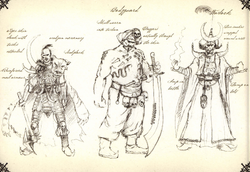
The Arabyans dress mostly with elegant turbans, baggy sleeves gathered on upper arm by armbands, jewelry, ornaments and decorated pieces of silk. Many protect themselves with tough leather boots, crossed daggers, whose handles carry jewels and precious stones, and high shoulder pads.[19a] Araby merchants, on the other hand, wear long robes of dark cloth, elaborate turbans, and incorporate jewellery when they can.[30f] The Arabyan women have the tradition to wear exotic hairstyles, with headbands and ornaments of gold and silver, dress in baggy pants and wear their bellies exposed, wearing a bedlah.[19a] The Arabyans women often wear a bracelet or anklet, a piece of jewellery worn on the wrist or ankle. They can be solid metal or supple chains studded with gemstones. Bracelets are popular among the Tilean and Estalian ladies as a result of the Arabyan influence in these lands.[30h]
For the Arabyans, clothing is extremely important. Dressing properly, and also wearing certain trinkets and ornaments, is a sign of composure and decency. Those civilized peoples must dress as such, and breaching this rule is an insult to all their compatriots, for this reason the Arabyans take great care in taking care of their appearance and clothing.[43a]
Architecture[]
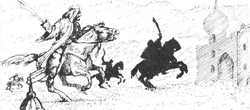
Nomads of the desert charge an Arabyan settlement.[29a]
Arabyan buildings often have domed roofs and distinctive onion-shaped arches over doors. A single building is frequently constructed around a courtyard, which may contain a garden if the owner is wealthy; otherwise, it is a storage and work area. Most have only a single floor and are built of brick rather than stone. Decoration almost never includes recognisable figures but can be very elaborate. These swirling, abstract patterns often look like the work of Chaos to men of the Empire, though those who know about Chaos can tell that it is not; it is too orderly. This decoration may be painted, in which case it has faded badly, or a mosaic that may be dirty but can still be seen.[46a]
Arabyan single rooms are watchtowers or the strong rooms of the main building. Single buildings are normally the homes of the wealthy or small outposts for the military. Some are the keep of a small fortress, or a small part of a larger fortress. Fortresses and small houses are more common than temples or palaces, and are composed of a central keep surrounded by a wall, with outbuildings in the space between the keep and the wall. Villages consist of a number of courtyard homes, while towns and cities are larger versions of villages.[46a]
Although without a doubt, if a building stands out above the rest, it is the palaces. Sultans, princes and emirs live in immense palaces built of white stone, topped by gigantic golden vaults. Its size is absolutely colossal, with dozens of gardens and rooms inside. Its splendor rises above the rest of the buildings, reaffirming the power of those who inhabit them.[28]
Arabyan Corsairs[]
Piracy is a fundamental pillar in Araby, sustaining many of its commercial activities.[11a] The corsairs are in charge of ending the rival fleets, thus monopolizing the trade routes.[14a] These corsairs orbit mostly around the city of Lashiek and Copher, being their base of operations, and the city where they can sell their loot of slaves.[11a] If Arabyans corsairs are renowned for something, it is for their discipline. They are cruel warriors, experts in navigation, who do not allow themselves to be intimidated in any sea.[3b] One of the most important of them all is the Sultan of the Seas, Golden Magus.[48a]
Slavery[]
In Araby they are slavers by nature, forming an essential part of both their economy and their society. Slavery is an unparalleled source of wealth for the corsairs and noblemen of Araby, who fill their markets with slaves from all over the world. The city of Lashiek is famous for being the world capital of slavery, hosting the largest known market for buying and selling slaves. This has caused that the simple name of this city produces terror in the navigators and merchants that surround its waters.[11a][1a] Many slaves serve in the Palaces of Pleasure, a destiny shared by men and woman, or to be part of the harems of the Arabyan rulers.[7a] The Sheikhs, Emirs and Sultans of Araby live in unimaginable luxury, served by hundreds of slaves who fulfil their every whim.[18a] Palaces of Pleasure and flesh pits are very common in every city of Araby.[47a]
Some babies are bought as slaves, and they are trained throughout their lives as Eunuch Warriors, being elite soldiers, disciplined and without the slightest hint of fear.[17b] His training takes place on the Eunuch Mountain, where the most famous Eunuch regiment of all, the Guard of Silence, is also located.[11a]
Arabyan slaveholders travel to distant Norsca in search of new shipments of slaves, many of them come from the Old World.[7a] Although, even with this constant trade, the Arabyans have not established an active slave exchange with Naggaroth, as the High Elves seek to prevent any ships from heading west from their lands.[11a] Corsairs travel to distant lands to sell exotic slave shipments, even trading with the Chaos Dwarfs. Slaves from distant lands and exotic races are especially sought after. Both harems full of beauties from Cathay and Ulthuan, and Eunuch Ogres who serve as an effective personal guard.[11a][48a]
Foreign Relations[]
Dwarfs[]
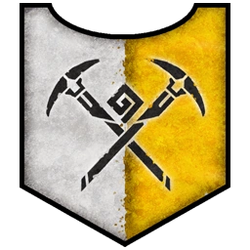
Heraldry of Greybeard's Prospectors' as depicted in Total War: Warhammer II.[61a]
The Dwarfs of Greybeard's Prospectors led by Thyk Skolsson are excavating the Atalan Mountains in search of precious materials.[61a]
High Elves[]
The Arabyans are great sailors and have for many centuries fished the adjoining seas and traded south along the coast, northwards to the Old World, and westwards as far as Ulthuan. The High Elves do not permit Arabyan vessels to travel further west than Ulthuan itself, their high-prowed dhows are a common sight in the outer harbours of Lothern. For their part the High Elves maintain a mercantile presence in Copher and Lashiek as they have since time immemorial. The Elves and men of Araby had dealings even during the long centuries when the Elves abandoned the Old World. Being not only capable seamen but also bold and adventurous, Arabyans will eagerly exchange fishing and trading for piracy, and nowhere is this more the case than in Lashiek which is consequently known as the City of Corsairs.[11a]
Marienburg[]
Marienburg but does not dominate trade in Araby as it does in the New World, Empire, and Norsca, mostly because of the closed, suspicious nature of Arabyan society. The emirs, sheikhs and caliphs distrust Marienburg's "government by usury" and fear that foreign sailors' talk of "ruling themselves" might seduce their own people. Consequently, outlanders are restricted to walled foreign quarters, beyond which Old Worlders venture at their own risk.[12f]
On the other hand, adventurous Arabian traders regularly sail their dhows to the Wasteland, knowing that they'll find ready buyers for their silks, spices, and oils. Over the centuries a small but thriving Arabyan community has grown in Marienburg, some families have been there for generations.[12f]
Skaven[]
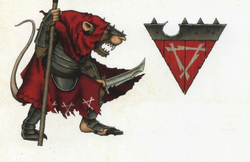
Emblem of Clan Skully
The arrival of the Skaven in Araby was called the Scouring of Scholars, with the creatures being seen as a holy punishment upon men who trusted too much in science.[9b]Template:OK
Clan Skully operated from Araby, specialising in the assassination techniques of the desert people instead of the techniques of Clan Eshin that were drawn from the traditions of Grand Cathay and Nippon in the Far East. Their leader was only known as the "Old Rat under the Mountain."[88a]
With many warrens underneath the sands of Araby, it is in Skully’s best interests to maintain favourable relations with Clan Pestilens and their extensive Southlands powerbase.[88a]
Tomb Kings[]
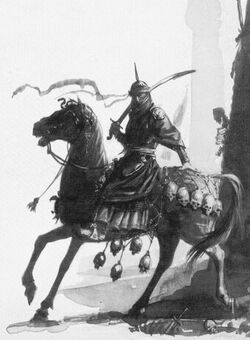
An Arabyan warrior scouting the dreaded Land of the Dead.
Crowds of nomads and adventurers from Araby venture into the Lands of the Dead to loot the tombs and obtain their treasures. Such as the famous treasure hunter Ibn Sullan, they long for the wealth forgotten in time, risking their lives among the sarcophagi. Occasionally, a young Sheikh, eager to prove his worth and that of his people, will venture into the Land of the Dead to claim treasures for himself and discover unknown riches.[31d][32a] Frequently, the leaders of Araby send their forces towards the pyramids of Nehekhara, with the mission of looting the tombs and burning the evil and ancient scrolls they find, thus preventing the dead from rising again. Sultans often hire mercenaries for these types of missions. They return to Tilea covered in wealth and valuable relics, though many fail to escape the wrath of the desert.[3e]
Tilea[]
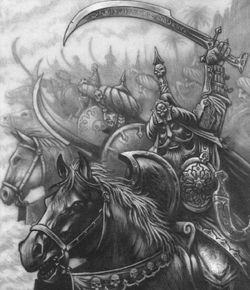
Al Muktar's Desert Dogs mercenary band famous in Tilea for taking part in the Rout of Rifraffa.
Despite the repeated raids of Arabyan privateers over the centuries it is the merchants of Tilea who do the greatest volume of Old World trade with Araby. The Arabyans love to trade with the Tilean merchants, with whom they have an excellent relationship. In Copher, the City of Spices, there is now a Tilean neighborhood, which is separated from the rest of the city by a wall.[3d]
Although there are frequent wars between rival sheikhs which occur in the interior of Araby, the Tileans try to avoid getting embroiled in local politics. However, the Tileans have occasionally financed mercenary armies in wars against the Undead who come from the east. Sometimes the leaders of Araby will hire mercenaries to investigate the various necropolises or ruined cities. They ransack the tombs to prevent the dead being raised and burn any evil scrolls that may be found. Any gold or treasure which is discovered is shared between the mercenaries as booty.[3d]
Strigany[]
Several scholars theorize that the Arabyan and the Strigany are cousins, beginning from a single source but traveling through different lands.[27b]Template:OK
Technology[]
Arabyans do travel and trade quite extensively, but they lack the self-motivation of most Old Worlders and have not yet made any serious attempts to settle outside of their homeland. Technologically they are becoming backward compared to their northern neighbours, although this was not formerly so.[17a] Arabyan society is feudal and perhaps not as technically advanced as that of the present-day nations of the Old Worlders, especially the Empire. They have some knowledge of gunpowder weapons, but their religious dogmas prevent them from developing further to create a more economically efficient societal organisation or to advance their base levels of technology.[17b]
Developed simultaneously with the invention of the wheellock mechanism by the Empire's engineers, the Arabyans invented the flintlock, a variation on the wheellock design. In this improved mechanism, the trigger released a small piece of flint to strike a steel plate to drop sparks into the pan.[30d] It must not surprise that the jezzail, a long-barrelled arquebus, was first designed in Araby, and since its inception, few have made their way to the Old World. Owned mostly by collectors and wealthy nobles, jezzails benefit from a longer range than their larger counterparts.[30e]
Magic[]
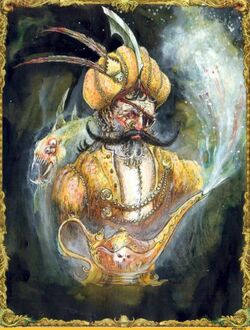
Golden Magus, the self-styled Sultan of the Seas
Araby lies far from the world's poles and therefore from the ultimate source of the magical winds that blow from the north. As a result magic that is common in the Old World is far more diffuse in Araby so it is much more difficult for sorcerers to work their spellcraft. Arabyan magic has therefore developed quite differently than that of other men. Arabyan sorcerers use their powers to control elemental spirits of the desert, Djinns, Efreets, Genies and such-like spirits. These spirits are worshipped by the superstitious and the common people of Araby. These so-called elemental creatures are all daemons of a kind, but so far removed and isolated from the source of magical power in the north that they rely upon the close presence of powerful magical artefacts to maintain their existence. They also sometimes cling to local areas where a vestige source of magical energy may be found, but in such cases their power is not usually great. Much Arabyan magic is based upon creating and using forms of magical containment such as cages, boxes, or crystals, which are used to capture and enslave these Daemons.[11a]Template:OK
Magic in Araby is divided among the flamboyant and fabulously wealthy sorcerers of the cities and the shamanistic mystics of the nomadic tribes.[32c]Template:OK
The power of the spirits has served to create a Lore of Magic typical of Araby, known as Arabyan Elemental Magic. Its spells contain unparalleled power, channeling the magical energies of these divine spirits.[11c][32d]Template:OK
One of the great works of Necromancy was produced in Araby: The Book of the Dead, written by the mad Arabyan prince Abdul ben Raschid. He travelled to the Land of the Dead in the east of Araby, and driven mad by his experiences, he wrote his blasphemous masterpiece. He did not live to see the widespread public revulsion of his work, or the great pyre where the Caliph of Ka-Sabar burned all the copies he could find. Unfortunately, many survived and were carried to the Old World by victorious knights during the Crusades.[35a]Template:OK In Araby, knowledge of necromancy is not suppressed, and so they do not suffer from the ignorance that allows Vampires to gain footholds amongst them as in the Empire. Only the Blood Dragons have a presence there, and that is in the western desert.[36a]Template:OK Works such as the Cursed Book, by the Arabyan necromancer Har-Ak-Iman, remain a remnant of this dark art among the dunes.[37a] At least in Copher, magical malfesances are punished.[90a]Template:OK
Magic items are common in Araby, used by its sorcerers and mystics. Among them are the renowned magic rugs, used as saddles by many renowned Arabyans. Other artifacts could be the Enchanted Ropes, living objects, that will help their master in battle. Being a society closely tied to magic, powerful relics and magical items are common among the people of Araby.[4b] Another of these artifacts would be the Arabyan Puzzlebox, an elegant mechanism that allows its wearer to take advantage of the Winds of Magic correctly, using the sparkling gems that it houses inside.[34a] Another example would be the Cobra Belt, a magical artifact that transforms into a poisonous snake at the command of its master.[38a] Ibn Naggazar was one of these renowned sorcerers, who in his brilliance, and also in his madness, wrote the Black Book of Ibn Naggazar. A tome where he compiled formulas to create intoxicating elixirs, influenced by the whispers of demons.[34a] Others speak of Kaphamon, an Arabyan magician skilled in the Lore of Death, who created a multitude of magical artifacts of incredible power, such as the Staff of Kaphamon.[36c]
In Araby there is the stain of Chaos, in the form of the Cult of Mirrors, worshipers of Tzeentch, among others.[39a]Template:OK Also, Beastmen roam this land. In Araby, unlike the Old World, Horned Ones do not have the appearance of bovids, but are described as Apemen. They are extremely intelligent, able to organize themselves and use weapons and tools in the cunning attacks they carry out against the other inhabitants of the jungle.[40a]
Religion[]
"You will understand, I know, that Oldworlders often do have such prejudice - it is like their reluctance to submit the world to the dominion of one god, though they are ready enough to acknowledge the many."
- —Orfeo the Minstrel to Alkadi Nasreen.[43a]Template:OK
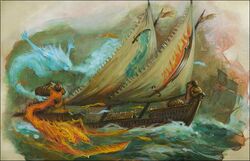
Flaming Scimitar surrounded by Djinns
Without a doubt, the Arabyan people especially adore the One God.[43a]Template:OK The High Priests of Araby attend to the marriages and coronations of the caliphs.[28]Template:OK Foreigners that seek to make a living in Araby are forced by the stern priests of Araby to "take the turban" and swear devotion to the One God.[43a]Template:OKArabyans worship Allah as manifest on earth by his chosen prophets. The words of the prophets are taken very seriously by the people and Sultan alike, and only a very foolish or stupid individual would go against a prophet of Allah.[17b]Template:OK
From an Old Worlder perspective, Arabyans are described as heathens, who are godless and bereft of faith.[19a]Template:OK Followers of the One God see as false deities those worshipped in the Old World such as Manann, God of the Sea, and Morr, the god of the dead.[43a]Template:OK
The festivals of some of the gods of the old Nehekharan Pantheon, such as Djaf, the god of death, are still observed by some Arabyans.[20a]Template:OK The Arabyans are meticulous about their burials, and is possible to see their great mausoleums described in the tomb of Muammar the Mad, a high priest of Araby buried in the Empire. They result in a series of chambers, with different statues, treasures, and canvas inside. The most prestigious Arabyans are buried covered in jewels, attracting crowds of grave robbers. The Arabyans themselves are mummified, a tradition inherited from the lost Nehekhara. Inside the mausoleums there are chapels for prayers, a dressing room with ritual paintings, and trunks with the ancient belongings of the deceased.[38a] Arabyan and Nehekharan tombs can be distinguished each from the other thanks to some differences, like the different locations of their entrances, owing to their different cultural beliefs about facing or shielding from the sun.[27a]Template:OK
Arabyans believe that at the moment of death, a man will access to one of the Seven Heavens, and those among them who find a glorious death will pass into the highest of them, known as St'oec.[56a]
Djinn, efreets, genies and such-like spirits are worshipped by the superstitious people of Araby. It is commonly believed that the spirits must be appeased with prayers and small tokens of respect such as gifts of food and drink. These so-called elemental creatures are all daemons of a kind, but so far removed and isolated from the source of magical power in the north that they rely upon the close presence of powerful magical artifacts to maintain their existence.[11a]Template:OK Beyond offerings and prayers, in their own culture they hide a multitude of popular sayings that refer to the Djinns. A common phrase to curse in Arabic would be: "May their souls be flayed by Djinn." A popular phrase of surprise or consternation would be: "Spirits of the sky, water and earth".[28]Template:OK
Other exclamations are "By the silver beard of Abdul ibn Ashid", "By Kasoun’s fiery sword" and "By the seven fathers of Mu'Allid",[28]Template:OK although what exactly this refers to or who these figures were is unknown to most Old Worldlers.
Arabyan Pantheon[]
- Nehekharan Pantheon - The festivals of some Nehekharan deities are still observed, such as Djaf.[20a]Template:OK
Military[]
"Much of the Butcher's army is Mameluk slave-soldiers, but armoured Janissaries and sun-blackened Dervishers march under the Black Lizard as well. Nomad riders guard the flanks and Sipahis on strong desert horses make up the vanguard."
- —The Duke of Aquitaine, observing the Arabyan army of Mehmed-bey, the Black Lizard.[25a]
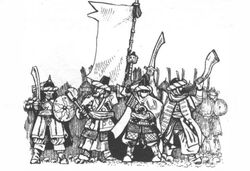
A group of Arabyan warriors[18]
The sultans are proud of their troops and especially of their cavalry so that no expense is spared either on their equipment or maintenance. It is popularly supposed that the horses of Araby are descended from Elven Steeds brought over from the west many centuries ago. They are graceful and swift creatures and very highly valued.[11a]Template:OK
The very best of the Arabyan foot-soldiers are also well equipped, with steel armour, keen tulwars, gleaming helmets, and fine silk clothing. These household troops or guards accompany the sultans when they travel beyond the grounds of their magnificent palaces. The loyalty of these troops is famous. They are amply rewarded with riches, luxuries, and prestige as a result. The ordinary foot soldiers are more plainly equipped and usually carry simple iron-hafted spears or bows. As well as these regular and garrison troops there are the irregular fighters from the desert tribes, including camel mounted warriors from the lands to the south and east.[11a]Template:OK
Arabian armies are based upon regiments of infantry. They garrison the cities and towns and enforce law and order throughout Araby as well as forming its standing army.[11a] Great use can be made of the unarmoured horsemen, who are able to skirmish against enemy formations whilst waiting to penetrate their lines and attack from the rear. Camels and Elephants have their place too. Elephants make excellent battering rams which can be charged against solid blocks of enemy troops. Elephants can be supponted by the Arabyans infantry, whilst the Dervishers rush ahead to tie up the advance enemy units.[71a]Template:OK
Arabyans warriors wear white or off-white clothing, with turbans often of a uniform colour within a Regiment. Some units may wear coloured their clothes with bright colors, over the tunics and trousers. Armour is often worn underneath the tunic, but where visible is steel, and ocasionally with bronze, copper or gold decoration. Regimental officers and some other personalities can wear black clothing, as do some of the desert tribemen. Weapons are of steel. Shields are generally of one solid colour, sometimes with decorative tassles made out of horse hair and dyed red. Spear shafts and bows are natural wood colour. Banners will be any solid colour and usually carry either a single device in a contrasting colour, or else reams and reams of text from the Great Sacred Books of the great arabyan sage Mullah Aklan'd.[71a]Template:OK
In Araby, heavy armour is impractical given the unforgiving climate. Instead, to shield themselves from the oppressive heat of the sun, they wear voluminous robes and body coverings that also making them harder to hit.[30b]Template:OK Araby merchants introduced the scimitar to the Old World. Though a sword, its curved blade, single edge, and lightweight lend it speed and accuracy in the hands of a skilled fighter. The severity of the curve varies considerably, though they are all equally effective. Scimitars, like swords, come in one- and two-handed varieties, with blades as long as 3 feet. It’s believed that scimitars evolved from the khopesh. One-handed scimitars have the same statistics as rapiers. Two-handed scimitars are big weapons; the blade widens as it reaches the tip. It has the same statistics as a great weapon.[30c]Template:OK
The Arabyans have made advances in Gunpowder Weapons, such as the Jezzail,[30e] Template:OK although how widespread they are among its troops is unknown. Among the most exotic weapons that we can find in Araby are; the Katar, a broad-bladed dagger, held by a glove to the hand. The Jambiya, a highly ornate curved dagger. And the Tufenk, light muskets used by some nomadic tribes.[32b]
Arabyan Infantry[]
- Arabyan Spearmen - Arabyan armies are based upon regiments of infantry. They garrison the cities and towns and enforce law and order throughout Araby as well as forming its standing army. The majority of these warriors carry tall spears and shields and fight in well-disciplined ranks.[11a]Template:OK
- Arabyan Guards - The household troops of the rulers of Araby, known in their own tongue as Janissaries, are famously loyal and lavishly equipped - they carry weapons of the finest quality and wear brightly coloured clothes of silk brocade.[11a]Template:OK
- Arabyan Bowmen - The men of Araby place great faith in the bow and all the cities of Araby maintain strong bodies of archers. Although firearms are known in Araby, they are nowhere near as common or as advanced as those used in the Old World and are rarely issued to common troops.[11a]Template:OK
- Dervishers - Considered to be the most notable units fielded in Araby, Dervishers are fanatic religious warriors all too willing to die for their god.[11a]Template:OK
- Mamelukes - A lowly form of slave-soldier, infamously utilised by Mehmed-bey during his battle against the Duke of Aquitaine.[25a]Template:OK
- Eunochs - Eunochs are only rarely slaves, more often they are individuals brought up and trained as warriors or guards. They are unusually steadfast and loyal.[17b]Template:OK
Arabyan Cavalry[]
- Arabyan Knights - Arabyan Knights, known in their own tongue as Sipahis, are the cavalry-elite of Araby. They are considered mad with hate, arrogant with pride and the terrors of the desert.[2][11b]Template:OK
- Arabyan Desert Riders - The deep deserts of Araby are home to fierce, nomadic Desert Riders. Known as Akincis in their own tongue, renown as fast nomad lancers and horse archers.[11b]Template:OK
- Arabyan Camel Riders - Camel Riders are an exotic form of cavalry utilised by the Arabyan military. It is only the fierce warriors of the desert tribes that ride these intractable creatures into battle. Camel Riders are brave and notoriously savage warriors.[11b]Template:OK
- Arabyan Flying Carpets - The sorcerers of Araby have perfected the art of binding aerial spirits into physical forms - not least of which is the famous Flying Carpet.[11b]Template:OK
Arabyan Warbeasts[]
- Elephants - Elephants are an exotic creature even in Araby for they come from the lush bushlands that lie between Araby and the jungles of the Southlands.[11b]Template:OK
Arabyan Heroes[]
- Arabyan Magicians - Arabyan Magicians, known in their own tongue as Fakirs, are the great sorcerers of Araby - mystics of the southern deserts and court magicians of the Sultans themselves.[11b]Template:OK
- Arabyan Champions - The Champions of Araby are often noble relatives to a Sheikh or other high ranking Commanders.[11b]Template:OK
Arabyan Lords[]
- Arabyan Commanders - The commander of an Arabyan army is likely to be a Grand Vizier - perhaps the Grand Vizier of the Great Sultan himself. Subordinate to the overall commander are marshals and commanders of lesser rank within the palace hierarchy, noble Emirs, and Sheiks from the desert.[11b]Template:OK
Notable Arabyans[]
- Abdul ben Raschid - Abdul ben Rachid was an Arabyan Prince of the Ka-Sabar Sultanate, known by the name of Abdul ben Raschid, ben Moussad, ben Osman. He became famous for capturing some Nagash manuscripts and for his insanity, becoming a scholar of death and its arts, and of the secrets of the fallen Nehekhara.
- Al Muktar's Desert Dogs - Al Muktar's Desert Dogs are a famous band of Dogs of War mercenaries that hail from the arid-deserts of great Araby.
- Fatandira - For generations, Arabyan nomads have roamed the Borderlands, even as far back as the Nehekharan Empire. From these people comes the second prince, Fatandira.
- Golden Magus - The Golden Magus, also called (by himself), the "Sultan of the Seas," is an eccentric Arabyan wizard from El-Khabbath, rich beyond the wildest dreams of a merchant prince. The Golden Magus is a man of exotic tastes and fine manner. But beneath this sophisticated exterior lies an elementalist of incredible power. Though in truth he is also a Tzeentchian sorcerer.
- Ibn Jellaba - bn Jellaba was a trader of Araby intent on opening up a trade route into the interior of the Southlands to procure spices and gold. He trekked over the desert with a camel caravan until he reached the jungles of the Southlands. Here he encountered the Lizardmen city of Zlatlan which had remained hidden for millennia. This Lizardmen realm far to the south of the great desert was known to the Arabyans only by rumour and legend, and the uncertain reports of chance encounters between desert nomads and the dreaded 'Al Saurim'.
- Khar-mel - Khar-mel is one of the few known Djinn of Araby.
- Mehmed-bey - Mehmed-bey, feared as Mehmed the Butcher and the Black Lizard, was one of Sultan Jaffar's greatest followers during the Crusade Against Araby.
- Suliman the Saracen - A fierce heroe, a skilled warrior, and a man of honour, he had no love or respect for the despot Jaffar during the Crusade Against Araby.
- Sultan Jaffar - Jaffar known in the past as Sultan of All Araby was a powerful sorcerer who, in 1435 IC, united Araby and was responsible for a major invasion of the Old World that triggered the Great Crusade Against Araby.
- Shihab Ibn Alim - Shihab Ibn Alim is a powerful Arabyan sorcerer in the service of the Sultan of Copher, with an innate ability to control powerful Djinns. He is perhaps the greatest threat to the Knights of Magritta, as his mission is to conspire and spy on this estalian order of chivalry, at odds with the lands of Araby since the time of the Crusade Against Araby.
Miniatures[]
Trivia[]
Araby is based on Medieval European ideas about the Islamic world and Middle Eastern mythology and fiction, as well as Historical aspects from the Ottoman Empire, specifically its military. The references refer to the entire Islamic world, from the African kingdoms such as Songhai to the different dynasties of the medieval caliphates. Geographically speaking, the area comprising real-world Arabia has been shifted and stuck to the northwest of the macro-area that mimics Africa in the world of Warhammer.[17b]
In earlier editions, natives of Araby were called "Arabs" and "Arabians",[17a] this was changed in later editions to "Arabyans", likely for copyright reasons. In Poland, the name "Arabia" is the official translation, but the natives of Araby are called "Arabianie" instead of "Arabowie" (the correct Polish way of writing "Arabs"). In Italian and Spanish versions they refer to the region as Arabia, and in French it is referred to as Arabie.
The Gulf of Medes that wets the interland of Araby takes its name from Medes, an ancient Iranian people who spoke the Median language and who inhabited an area known as Media between western and northern Iran.
In White Dwarf 86, an Arabian-like city named Barrakeesh was introduced within the fantastical world of Magnamund. The adventure set in Barrakeesh was intentionally designed to be adaptable across various roleplaying systems, including Warhammer Fantasy Roleplay: 1st Edition.[57a] Additionally, Citadel has produced a flying carpet said to be from Barrakeesh.[13a]
Sources[]
- 1: Warhammer Armies: Bretonnia (5th Edition)
- 1a: pg. 13
- 2: Warhammer Armies: Bretonnia (6th Edition)
- 2a: pg. 33
- 3: Warhammer Armies: Dogs of War (5th Edition)
- 4: Warhammer Fantasy Roleplay 1st Edition: Core Rulebook (RPG)
- 5: Warhammer Fantasy Roleplay 2nd Edition: Core Rulebook (RPG)
- 6: Warhammer Fantasy Roleplay 2nd Edition: Shades of the Empire (RPG)
- 7: Warhammer Fantasy Roleplay 2nd Edition: Tome of Corruption (RPG)
- 8: Warhammer Fantasy Roleplay 2nd Edition: Knights of the Grail (RPG)
- 8a: pg. 20
- 9: Warhammer Fantasy Roleplay 2nd Edition: Children of the Horned Rat (RPG)
- 10: Warhammer Fantasy Roleplay 2nd Edition: Tome of Salvation (RPG)
- 11: Warmaster: Armies (Specialist Game)
- 12: Warhammer Fantasy Roleplay 1st Edition: Marienburg - Sold down the River (RPG)
- 13: White Dwarf 67
- 13a: pg. 38
- 14: Warhammer Armies: Lizardmen (5th Edition)
- 14a: pp. 6-8
- 15: Warhammer Armies: Lizardmen (6th Edition)
- 16: Warhammer Armies: Tomb Kings (8th Edition)
- 17: Rulebook - Battle Bestiary (2nd Edition)
- 18: Warhammer Fantasy: Rulebook (6th Edition)
- 18a: pg. 167
- 19: Blood on the Reik (Background Book)
- 19a: pp. 74-76 Races of the Old World
- 20: Warhammer Armies: Tomb Kings (6th Edition)
- 21: Warhammer Fantasy Roleplay 2nd Edition: Companion (RPG)
- 22: White Dwarf 207
- 22a: pp. 23-26
- 23: White Dwarf 234
- 23a: pg. 46
- 24: Liber Necris (Background Book)
- 25: The Red Duke (Novel) by C. L. Werner
- 25a: pp. 161-163
- 26: Gotrek and Felix: Giant Slayer (Novel) by William King
- 26a: Prologue
- 27: Daemon Gates - Night of the Daemon (Novel) by Aaron Rosenberg
- 28: Gotrek and Felix: Two Crowns of Ras Karim (Novel) by Nathan Long
- 29: Forces of Fantasy - A Warhammer Supplement (1st Edition)
- 29a: pg. 10
- 30: Warhammer Fantasy Roleplay 2nd Edition: Old World Armoury (RPG)
- 31: Town Cryer 19
- 32: Town Cryer 20
- 33: Sigmar's Blood (Novel) by Phil Kelly
- 33a: The Hidden Necropolis
- 34: Warhammer Fantasy: Storm of Magic (8th Edition)
- 35: Warhammer Armies: Vampire Counts (5th Edition)
- 35a: pg. 8
- 36: Warhammer Fantasy Roleplay 2nd Edition: Night's Dark Masters (RPG)
- 37: Warhammer Armies: Vampire Counts (8th Edition)
- 37a: pg. 63
- 38: Warhammer Fantasy Roleplay 1st Edition: Death's Dark Shadow (RPG)
- 38a: pg. 75-76
- 39: Warhammer Armies: Daemons of Chaos (8th Edition)
- 39a: pg. 18
- 40: Warhammer Armies: Beastmen (6th Edition)
- 40a: pg. 16
- 41: Storm Warriors (Novel) by Brian Craig
- 41a: Prologue
- 42: Warhammer Armies: Warriors of Chaos (7th Edition)
- 42a: pg. 17
- 43: Zaragoz (Novel) by Brian Craig
- 43a: Prologue
- 44: Plague Daemon (Novel) by Brian Craig
- 44a: Prologue
- 45: Fell Cargo (Novel) by Dan Abnett
- 45a: Ch. 24
- 46: Warhammer Fantasy Roleplay 2nd Edition: Renegade Crowns (RPG)
- 47: Old World Bestiary (Fantasy Roleplay)
- 47a: pg. 9
- 48: Dreadfleet (Novel) by Phil Kelly
- 48a: Ch. 17
- 49: Time of Legend: Nagash Immortal (Novel) by Mike Lee
- 49a: Ch. 12: Children of a Hungry God
- 50: Warhammer Armies: Undead (4th Edition)
- 51: Warhammer Armies: The Empire (8th Edition)
- 51a: pp. 41-43
- 52: White Dwarf 310
- 52a: pg. 121
- 53: Redhand's Daughter (Novel) by William King
- 54: The Voyage South (Novel) by Nicola Griffith
- 55: Warhammer: Von Carstein Trilogy: Inheritance (Novel) by Steven Savile
- 55a: Ch. 14
- 56: Warhammer: Citadel Journal Spring 1985
- 56a: pg. 49
- 57: White Dwarf 68
- 57a: pg. 48
- 58: Town Cryer 21
- 58a: pg. 16
- 59: White Dwarf 277
- 59a: pg. 18
- 60: White Dwarf 275
- 60a: pg. 19
- 61: Total War: Warhammer II (PC Game)
- 61a: Campaign map
- 62: Citadel Miniatures: Regiments of Renown '85
- 63: Time of Legend: Nagash The Sorcerer (Novel) by Mike Lee
- 64: Time of Legend: Master of Death (Novel) by Josh Reynolds
- 64a: Chapter 12
- 65: Talon of Khorne (Short Story by Frank Cavallo)
- 66: Warhammer Fantasy Roleplay 4th Edition: Starter Pack - The Adventure Book (RPG)
- 66a: pg. 35
- 67: White Dwarf 244
- 67a: pp. 88-89
- 68: Warhammer Armies: Tomb Kings (7th Edition)
- 68a: pg. 9
- 69: Warhammer Fantasy Roleplay 1st Edition: Something Rotten in Kislev (RPG)
- 69a: pg. 12
- 70: Warhammer Armies: Lizardmen (7th Edition)
- 70a: pg. 24
- 71: "Forces of Fantasy": A Warhammer Supplement: Fighting Fantasy Battles (1st Edition)
- 72: Warhammer Fantasy Roleplay 2nd Edition: The Thousand Thrones (RPG)
- 72a: pg. 157
- 73: The Blades of Chaos (Novel) by Gav Thorpe
- 74: Warhammer Armies: Daemons of Chaos (7th Edition)
- 74a: pg. 28
- 75: Map of Araby
- 76: White Dwarf 288
- 76a: pg. 36
- 77: Archaon: Lord of Chaos (Novel) by Rob Sanders
- 77a: Ch. 14
- 78: Warhammer Fantasy Roleplay 2nd Edition: The Warhammer Fantasy Roleplay Companion (RPG)
- 78a: pg. 80
- 79: Renegade Crowns (2nd Edition Fantasy Roleplay)
- 79a: pg. 117-118
- 80: Neferata (Novel) by Josh Reynolds
- 81: Warhammer Armies: Hordes of Chaos (6th Edition)
- 81a: pg. 14
- 82: The Last Charge (Short Story) by Andy Hoare
- 83: Citadel Journal 8 (Magazine)
- 83a: pg. 19
- 84: Van Horstmann (Novel) by Ben Counter
- 84a: Ch. 8
- 85: Citadel Journal - Spring 86
- 85a: pg. 27
- 86: Warhammer Fantasy Roleplay 2nd Edition: Lure of the Liche Lord (RPG)
- 86a: pp. 14-15
- 87: Blood and Sand (Short Story) by Matt Ralphs
- 88: The Black Plague: Dead Winter (Novel) by C. L. Werner
- 88a: Ch. 2
- 89: Warhammer Fantasy Roleplay 4th Edition: Starter Pack - The Adventure Book (RPG)
- 89a: pg. 139
- 90: Warhammer Fantasy Roleplay 4th Edition: Middenheim - City of the White Wolf (RPG)
- 90a: pg. 106




